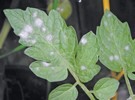The approach to day-time humidity in the semi-closed glasshouse differs much from the conventional glasshouse. But how does the superior air movement affect the plants at night? Godfrey Dol, an expert on cultivation in semi-closed glasshouses, digs into it.
In a conventional glasshouse, growers will turn on the heating system when the humidity deficit (HD) falls below 1.0-2.0 grams per cubic meter, even if there is no heat requirement to keep the plants warm. The heat moves and warms the air creating a lower HD. Moisture is expelled through the vents. This helps prevent diseases such as Powdery Mildew and Botrytis. In a semi-closed glasshouse, it is safe to go as low as an HD of 0.2-0.5. This has significant consequences for heating cost and energy use.
If we think about why conventional glasshouse growers want to use the heating system to reduce humidity, it is because the heat moves the air. The fans in a semi-closed glasshouse do a much better job (and it is cheaper) compared to heating.
If we think about the real reason why growers turn on the heating system at a humidity of more than 85% (HD=1.3 at 18 degrees Celsius), it is because the measuring box that measures the humidity, is located near the top of the plant. A humidity of 85% in a conventional glasshouse means that in the lower region of the glasshouse, where there are lots of leaves, and little air circulation, the humidity must approach 100%. It is this humidity that causes Botrytis and Powdery Mildew.
In a semi-closed glasshouse, the fans create a more homogeneous climate. A humidity of 85% near the top means that the humidity is also 85% near the bottom. It is estimated that 20-30% of fuel usage in a conventional glasshouse is used for dehumidification. A semi-closed glasshouse will reduce this significantly.
Night-time cooling and humidity
What about cooling at night? Can we reduce the 24-hour temperature at night by using the pad wall for cooling on a warm night? It seems counterintuitive to bring moisture into a glasshouse at night. Surely this will encourage Botrytis and Powdery Mildew. Godfrey wants to show an example.
If the outside temperature is 20 degrees, and the humidity is 60%, the wet bulb temperature is 15.1. This means we can blow in air of 15.1 Celsius at 100% humidity by turning on the pad wall. If we increase the temperature in the glasshouse to 18 degrees, the corresponding humidity is 84%, which is more than acceptable for night-time humidity.
If we think back to the fear of introducing moisture into the glasshouse at night, we can now see that there is no risk of condensation if the blow in temperature in the glasshouse is lower than the glasshouse air temperature.
 As a result, we can cool and humidify the blow in air if we think there is an advantage for the plant, without fear of exaggerating the chance of disease. This is particularly relevant when the daytime temperature is high, and the glasshouse needs to be kept cool at night to reduce the 24-hour temperature.
As a result, we can cool and humidify the blow in air if we think there is an advantage for the plant, without fear of exaggerating the chance of disease. This is particularly relevant when the daytime temperature is high, and the glasshouse needs to be kept cool at night to reduce the 24-hour temperature.
It is not unusual to see an inside temperate that is more than 10 degrees Celsius lower than the outside temperature when the night humidity is below 35%. Plants prefer a higher humidity at night. A relative humidity of less than 75% at night is not desirable.
Figure 1: Powdery Mildew in Tomatoes
Dark weather
During extended periods of dark weather, plants will shed their roots because, like a muscle, if you don’t use them, you lose them. Growers in conventional glasshouses try to prevent this by putting a minimum pipe in the glasshouse and open the vents. This will increase transpiration when there is a lack of sunlight. Root die back will be limited, and the action better prepares the plant for the next sunny say which will inevitably come.
In a-semi closed glasshouse the fans do the activation and can create a lot more transpiration by moving the air more quickly. Even if the glasshouse is in recirculation mode and the air exchange to the outside is zero, the plant will still be activated by the air currents if the humidity is below 100%.Turning up the fan speed and achieving 5-6 air exchanges per hour is according to Godfrey an excellent way to prevent root die off and have your plants ready for the first sunny day.
In his last post, Godfrey displayed a table with recommended humidity deficits. He made a differentiation between a HD that had a vegetative and generative effect on the plant. Some people found it difficult to understand why a high humidity has a generative effect on a plant. For them, Godfrey recommends a previous post in which this is explained.
In his next post Godfrey will discuss what pests and disease pressures can be significantly reduced in a semiclosed glasshouse.
This article is part of a series about growing in a semi-closed greenhouse. Read here more about no-go's for semi-closed glasshouses, cooling, the difference between semi-closed and pad and fan glasshouses and how to prevent momentum, becoming a crop to vegetative and humidity, for example in tomato.
For more information:
Glasshouse Consultancy
www.glasshouse-consultancy.com
Godfrey Dol
LinkedIn
[email protected]
+81 80 700 94 006
